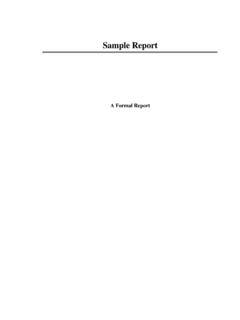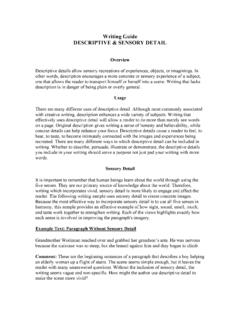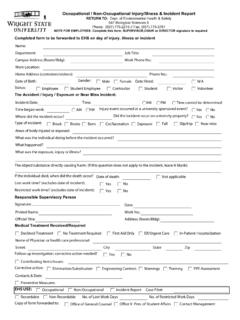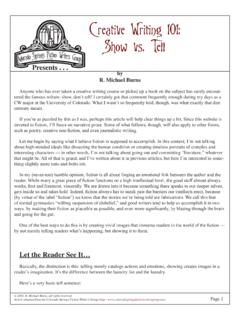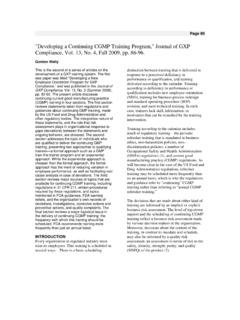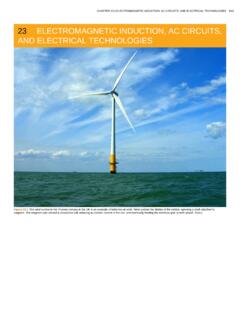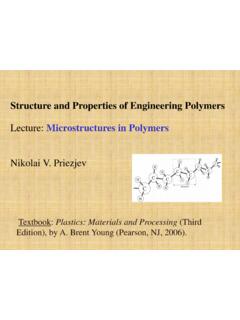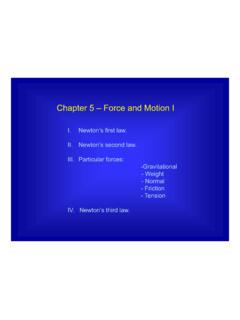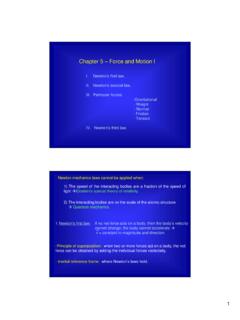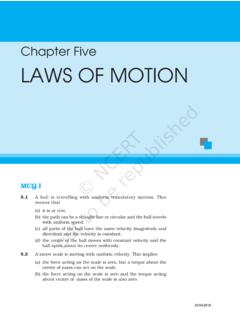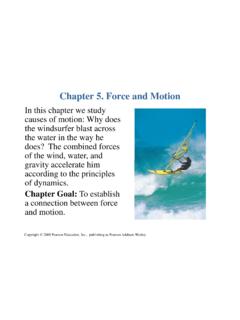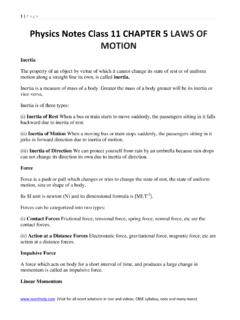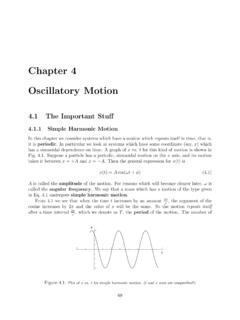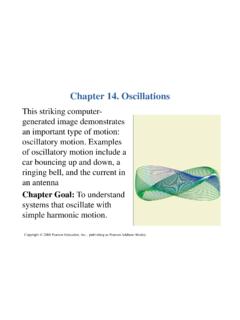Transcription of 4 DYNAMICS: FORCE AND NEWTON'S LAWS OF MOTION
1 4 DYNAMICS: FORCE AND NEWTON'S LAWS OFMOTIONF igure s laws of MOTION describe the MOTION of the dolphin s path. (credit: Jin Jang)Learning Development of FORCE Concept Understand the definition of Newton s First Law of MOTION : Inertia Define mass and inertia. Understand NEWTON'S first law of Newton s Second Law of MOTION : Concept of a System Define net FORCE , external FORCE , and system. Understand Newton s second law of MOTION . Apply Newton s second law to determine the weight of an Newton s Third Law of MOTION : Symmetry in Forces Understand NEWTON'S third law of MOTION . Apply NEWTON'S third law to define systems and solve problems of Normal, Tension, and Other Examples of Forces Define normal and tension forces. Apply NEWTON'S laws of MOTION to solve problems involving a variety of forces. Use trigonometric identities to resolve weight into Problem-Solving Strategies Understand and apply a problem-solving procedure to solve problems using NEWTON'S laws of Further Applications of Newton s Laws of MOTION Apply problem-solving techniques to solve for quantities in more complex systems of forces.
2 Integrate concepts from kinematics to solve problems using NEWTON'S laws of Extended Topic: The Four Basic Forces An Introduction Understand the four basic forces that underlie the processes in 4 | DYNAMICS: FORCE AND NEWTON'S LAWS OF MOTION 123 Introduction to Dynamics: Newton s Laws of MotionMotion draws our attention. MOTION itself can be beautiful, causing us to marvel at the forces needed to achieve spectacular MOTION , such as that of adolphin jumping out of the water, or a pole vaulter, or the flight of a bird, or the orbit of a satellite. The study of MOTION is kinematics, but kinematicsonlydescribesthe way objects move their velocity and their the forces that affect the MOTION of moving objectsand systems. Newton s laws of MOTION are the foundation of dynamics. These laws provide an example of the breadth and simplicity of principlesunder which nature functions.
3 They are also universal laws in that they apply to similar situations on Earth as well as in Newton s (1642 1727) laws of MOTION were just one part of the monumental work that has made him legendary. The development of Newton slaws marks the transition from the Renaissance into the modern era. This transition was characterized by a revolutionary change in the way peoplethought about the physical universe. For many centuries natural philosophers had debated the nature of the universe based largely on certain rules oflogic with great weight given to the thoughts of earlier classical philosophers such as Aristotle (384 322 BC). Among the many great thinkers whocontributed to this change were Newton and Newton s monumental work,Philosophiae Naturalis Principia Mathematica, was published in 1687. It proposed scientific laws that are still used today todescribe the MOTION of objects.
4 (credit: Service commun de la documentation de l'Universit de Strasbourg)Galileo was instrumental in establishingobservationas the absolute determinant of truth, rather than logical argument. Galileo s use of thetelescope was his most notable achievement in demonstrating the importance of observation. He discovered moons orbiting Jupiter and made otherobservations that were inconsistent with certain ancient ideas and religious dogma. For this reason, and because of the manner in which he dealtwith those in authority, Galileo was tried by the Inquisition and punished. He spent the final years of his life under a form of house arrest. Becauseothers before Galileo had also made discoveries byobservingthe nature of the universe, and because repeated observations verified those ofGalileo, his work could not be suppressed or denied. After his death, his work was verified by others, and his ideas were eventually accepted by thechurch and scientific also contributed to the formation of what is now called Newton s first law of MOTION .
5 Newton made use of the work of his predecessors, whichenabled him to develop laws of MOTION , discover the law of gravity, invent calculus, and make great contributions to the theories of light and color. It isamazing that many of these developments were made with Newton working alone, without the benefit of the usual interactions that take place amongscientists was not until the advent of modern physics early in the 20th century that it was discovered that Newton s laws of MOTION produce a goodapproximation to MOTION only when the objects are moving at speeds much, much less than the speed of light and when those objects are larger thanthe size of most molecules (about10 9min diameter). These constraints define the realm of classical mechanics, as discussed inIntroduction tothe Nature of Science and Physics. At the beginning of the 20thcentury, Albert Einstein (1879 1955) developed the theory of relativity and, alongwith many other scientists, developed quantum theory.
6 This theory does not have the constraints present in classical physics. All of the situations weconsider in this chapter , and all those preceding the introduction of relativity inSpecial Relativity, are in the realm of classical Connections: Past and Present PhilosophyThe importance of observationand the concept ofcause and effectwere not always so entrenched in human thinking. This realization was a partof the evolution of modern physics from natural philosophy. The achievements of Galileo, Newton, Einstein, and others were key milestones inthe history of scientific thought. Most of the scientific theories that are described in this book descended from the work of these Development of FORCE ConceptDynamicsis the study of the forces that cause objects and systems to move. To understand this, we need a working definition of FORCE . Our intuitivedefinition offorce that is, a push or a pull is a good place to start.
7 We know that a push or pull has both magnitude and direction (therefore, it is avector quantity) and can vary considerably in each regard. For example, a cannon exerts a strong FORCE on a cannonball that is launched into the contrast, Earth exerts only a tiny downward pull on a flea. Our everyday experiences also give us a good idea of how multiple forces add. If twopeople push in different directions on a third person, as illustrated inFigure , we might expect the total FORCE to be in the direction shown. Sinceforce is a vector, it adds just like other vectors, as illustrated inFigure (a) for two ice skaters. Forces, like other vectors, are represented by arrowsand can be added using the familiar head-to-tail method or by trigonometric methods. These ideas were developed chapter 4 | DYNAMICS: FORCE AND NEWTON'S LAWS OF MOTIONThis content is available for free at (a) shows an overhead view of two ice skaters pushing on a third.
8 Forces are vectors and add like other vectors, so the total FORCE on the third skater is in thedirection shown. In part (b), we see a free-body diagram representing the forces acting on the third (b) is our first example of afree-body diagram, which is a technique used to illustrate all theexternal forcesacting on a body. The bodyis represented by a single isolated point (or free body), and only those forces actingonthe body from the outside (external forces) are shown. (Theseforces are the only ones shown, because only external forces acting on the body affect its MOTION . We can ignore any internal forces within the body.)Free-body diagrams are very useful in analyzing forces acting on a system and are employed extensively in the study and application of Newton slaws of more quantitative definition of FORCE can be based on some standard FORCE , just as distance is measured in units relative to a standard possibility is to stretch a spring a certain fixed distance, as illustrated inFigure , and use the FORCE it exerts to pull itself back to its relaxedshape called arestoring FORCE as a standard.
9 The magnitude of all other forces can be stated as multiples of this standard unit of FORCE . Many otherpossibilities exist for standard forces. (One that we will encounter inMagnetismis the magnetic FORCE between two wires carrying electric current.)Some alternative definitions of FORCE will be given later in this FORCE exerted by a stretched spring can be used as a standard unit of FORCE . (a) This spring has a lengthxwhen undistorted. (b) When stretched a distance x, the spring exerts a restoring FORCE ,Frestore, which is reproducible. (c) A spring scale is one device that uses a spring to measure FORCE . The forceFrestoreisexerted on whatever is attached to the hook. HereFrestorehas a magnitude of 6 units in the FORCE standard being Experiment: FORCE StandardsTo investigate FORCE standards and cause and effect, get two identical rubber bands. Hang one rubber band vertically on a hook.
10 Find a smallhousehold item that could be attached to the rubber band using a paper clip, and use this item as a weight to investigate the stretch of the rubberband. Measure the amount of stretch produced in the rubber band with one, two, and four of these (identical) items suspended from the rubberband. What is the relationship between the number of items and the amount of stretch? How large a stretch would you expect for the samenumber of items suspended from two rubber bands? What happens to the amount of stretch of the rubber band (with the weights attached) if theweights are also pushed to the side with a pencil? Newton s First Law of MOTION : InertiaExperience suggests that an object at rest will remain at rest if left alone, and that an object in MOTION tends to slow down and stop unless some effortis made to keep it moving. WhatNewton s first law of motionstates, however, is the following:Newton s First Law of MotionA body at rest remains at rest, or, if in MOTION , remains in MOTION at a constant velocity unless acted on by a net external the repeated use of the verb remains.

